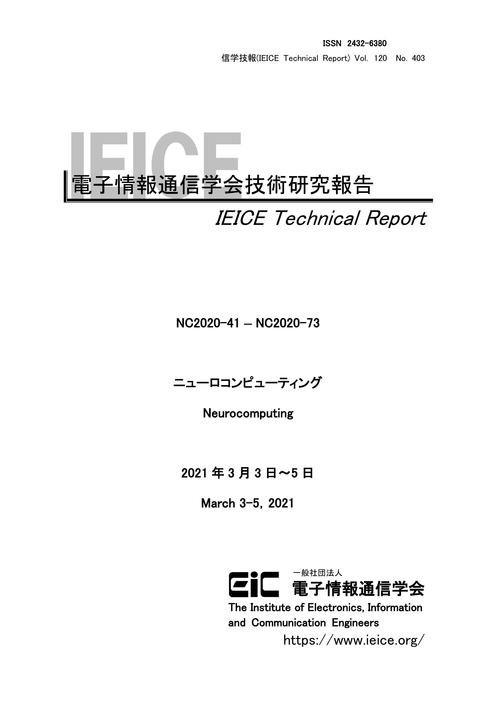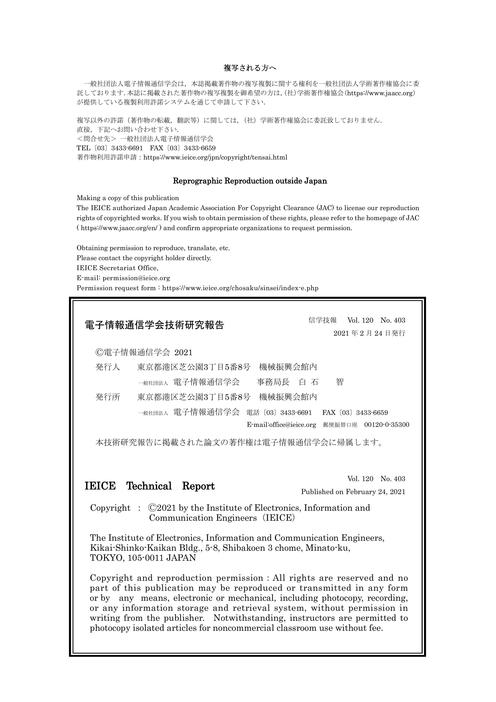

Online edition: ISSN 2432-6380
[TOP] | [2017] | [2018] | [2019] | [2020] | [2021] | [2022] | [2023] | [Japanese] / [English]
NC2020-41
Network cores of the human functional connectome
Tomoya Taguchi, Jun Kitazono (Univ. of Tokyo), Shuntaro Sasai (Araya Inc.), Masafumi Oizumi (Univ. of Tokyo)
pp. 1 - 6
NC2020-42
Neuronal correlation between the responses to surface and shape in monkey V4
Itsuki Machida, Atsushi Kodama, Ko Sakai (Univ. of Tsukuba)
pp. 7 - 10
NC2020-43
Evaluation of the relationship between ability to acquire predictive optokinetic response and capacity of the velocity storage mechanism in different animal species.
Toshimi Yamanaka (Chubu Uni), Rosendo G. Hernandeza, Pablo M. Blazquez (WUSM), Yutaka Hirata (Chubu Uni)
p. 11
NC2020-44
Influence of vestibular neurectomy on the velocity storage mechanism predicted by the neural network model of the optokinetic response faithfully reflecting the cerebellum-brainstem connectome.
Yusuke Shinji, Yutaka Hirata (Chubu Univ.)
pp. 12 - 16
NC2020-45
Direction-selective motion detection simulation of the optic lobe using Drosophila connectome
Munehiro Hayashi, Takayuki Okuda, Hayato Tsunoda (UTokyo), Tomoki Kazawa, Ryohei Kanzaki (RCAST)
pp. 17 - 20
NC2020-46
Hybrid Sparsity in Convolutional Neural Networks
Shoma Noguchi, Yukari Yamauchi (Nihon Univ.)
pp. 21 - 24
NC2020-47
Visualization of CNNs using Preferred Stimulus in Receptive Fields
Genta Kobayashi, Hayaru Shouno (UEC)
pp. 25 - 30
NC2020-48
Analysis of deep convolutional neural network texture representation using Portilla-Simoncelli statistics
Yusuke Hamano, Hayaru Shouno (UEC)
pp. 31 - 36
NC2020-49
Emotion Estimation from EEG data by Multi-Dimensional CNN
Mizuki Noda, Masayuki Kikuchi (TUT)
pp. 37 - 40
NC2020-50
Identification of information propagation pathways in the brain that contribute to the realization of mindfulness state by the maximum-flow problem
Haruka Nakamura, Yoshimasa Tawatsuji, Tatsunori Matsui (Waseda Univ.), Makoto Nakamura, Koichi Kimura, Hisanori Fujisawa (FUJITSU LABORATORIES LTD.)
pp. 41 - 46
NC2020-51
A Study on Feature Extraction of signal arrival order using unsupervised learning of the pulsed neuron model
Kaya Teramoto, Susumu Kuroyanagi (NIT)
pp. 47 - 52
NC2020-52
What is the true objective of multi-task manifold modeling?
-- Comparison of maximum likelihood and optimal transport approaches --
Ryo Tsuno, Hideaki Ishibashi, Tetsuo Furukawa (KIT)
pp. 53 - 58
NC2020-53
Realization of Global Search and Local Search in Particle Multi-Swarm Optimization
Hiroshi Sho (Kyutech)
pp. 59 - 64
NC2020-54
Proposal of higher-order tensor independent component analysis for MIMO remote sensing systems
Seishiro Goto, Ryo Natsuaki, Akira Hirose (The Univ. of Tokyo)
pp. 65 - 70
NC2020-55
An Estimated Intersections Reduction Method for Percussion Source Separation Based on the U-Net
Daisuke Tanaka, Susumu Kuroyanagi (NIT)
pp. 71 - 76
NC2020-56
Evaluation of effect of source noise on magnetoencephalography source estimation using a structured sparse model
Kai Miyazaki, Shun Nirasawa, Kazuaki Akamatsu, Yoichi Miyawaki (UEC)
pp. 77 - 82
NC2020-57
What characteristics are acquired in coding self-motion from visual motion?
-- Reconstruction of statistical relationship by neural network and its internal representation --
Daiki Nakamura, Hiroaki Gomi (NTT)
pp. 83 - 88
NC2020-58
An analysis of conductors'body and baton movement: exploring the communication mechanism of music conducting.
Nozomi Yamakawa, Yutaka Sakaguchi (UEC)
pp. 89 - 94
NC2020-59
"Piling up bones":An experimental study on functional standing
Tajima Hiroyuki, Sakaguchi Yutaka (UEC)
pp. 95 - 100
NC2020-60
Movement features affecting judgement of proficiency of classic ballet dancing
-- An analysis of flapping movement of white swan --
Atsushi Hosoi, Kojiro Ojima (UEC), Yui Kawano (JISS), Mayumi Kuno-Mizumura (Ochanomizu Univ.), Yutaka Sakaguchi (UEC)
pp. 101 - 105
NC2020-61
A reflex control model of hexapods using joint elasticity
Masayuki Nagahori (Yamaguchi Univ.), Dai Owaki (Tohoku Univ.), Jun Nishii (Yamaguchi Univ.)
pp. 106 - 111
NC2020-62
Hierarchical Feature Extraction for Dynamic Q-Network
Taishi Komatsu, Yukari Yamauchi (Nihon Univ.)
pp. 112 - 116
NC2020-63
A3C with Deterministic Policy Gradient
Yu Takahagi, Yukari Yamauchi (Nihon Univ.)
pp. 117 - 120
NC2020-64
Quaternion neural networks for channel prediction including polarization states
Haotian Chen, Ryo Natsuaki, Akira Hirose (Tokyo Univ.)
pp. 121 - 126
NC2020-65
Aspect classification by using complex-valued reservoir computing
Bungo Konishi, Akira Hirose, Ryo Natsuaki (UT)
pp. 127 - 132
NC2020-66
On an online learning rule for reservoir neural network hardware
Kaito Kudo, Keisuke Fukuda, Yoshihiko Horio (Tohoku Univ.)
pp. 133 - 138
NC2020-67
Proposal of Self-Organizing Incremental Neural Network based on Sparsity
Yuta Morikawa, Yukari Yamauchi (Nihon Univ)
pp. 139 - 144
NC2020-68
Memory Capacity of Sparse-Coding Hopfield model Implemented on Coherent Ising Machine
Ryuta Sasaki, Toru Aonishi (TokyoTech), Kazushi Mimura (Hiroshima City Univ.), Masato Okada (Univ. Tokyo), Yoshihisa Yamamoto (NTT/Stanford Univ.)
pp. 145 - 150
NC2020-69
The Relation between Sensitivity and Maximum Lyapunov Exponent when Sensitivity Adjustment Learning is Applied to Layered Recurrent Neural Networks
Takuya Ejima, Yuuki Tokumaru, Kastunari Shibata (Oita Univ.)
pp. 151 - 156
NC2020-70
Applying Ensemble Learning in Relay BP
Keisuke Toyama, Yukari Yamauchi (Nihon Univ.)
pp. 157 - 162
NC2020-71
DCSOM with Ensemble Learning Classifier
Akito Takahashi, Yukari Yamauchi (Nihon Univ)
pp. 163 - 168
NC2020-72
Adaptive Optimization Method in Artificial Neural Network that Independ on Learning Rate
Tetsuya Sato, Yukari Yamauti (Nihon Univ.)
pp. 169 - 173
NC2020-73
Safe Pattern Pruning for Non-monotonic Feature on Predictive Pattern Mining
Hagawa Seiji, Karasuyama Masayuki (NITech)
pp. 174 - 179
Note: Each article is a technical report without peer review, and its polished version will be published elsewhere.